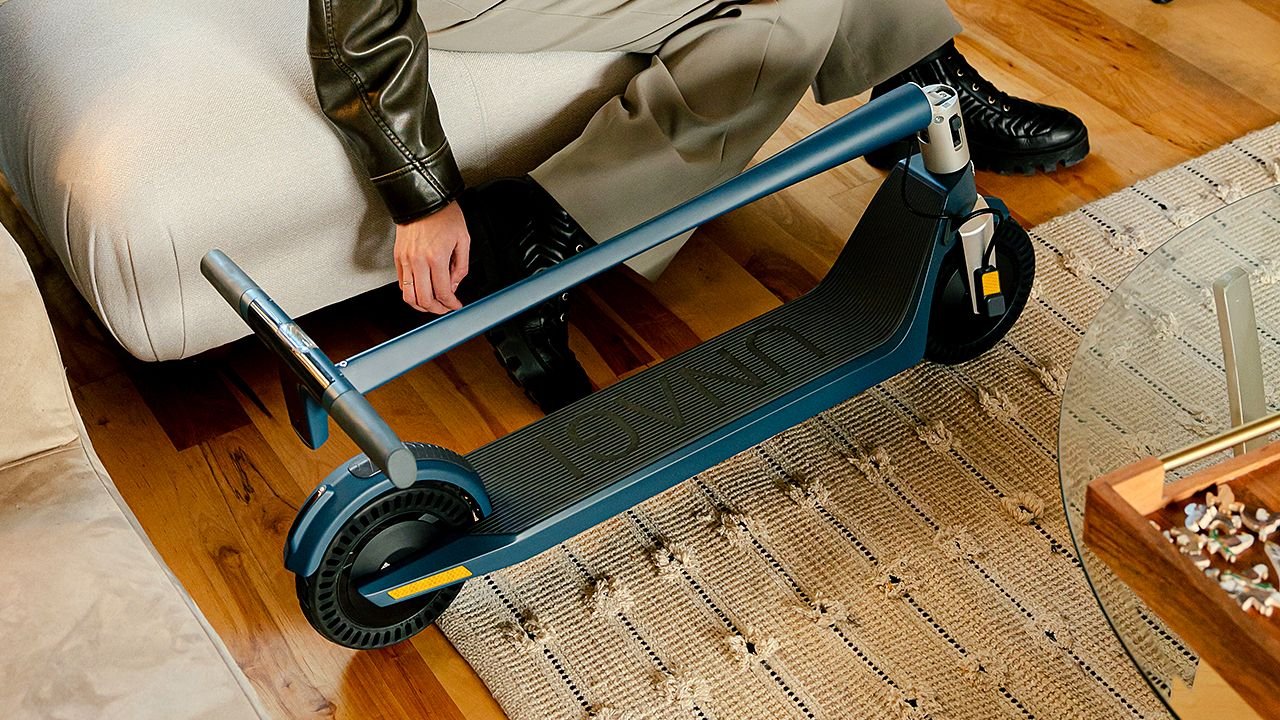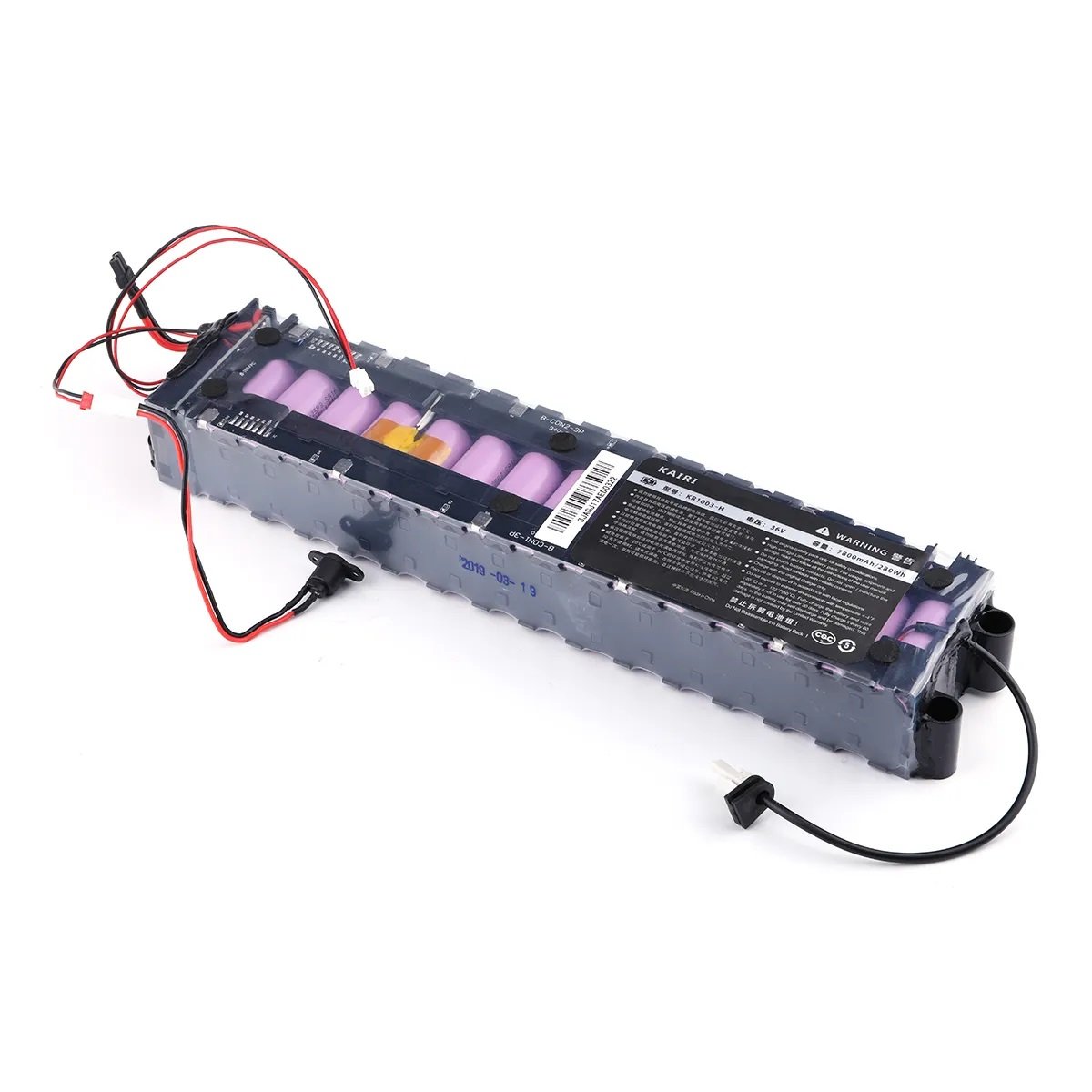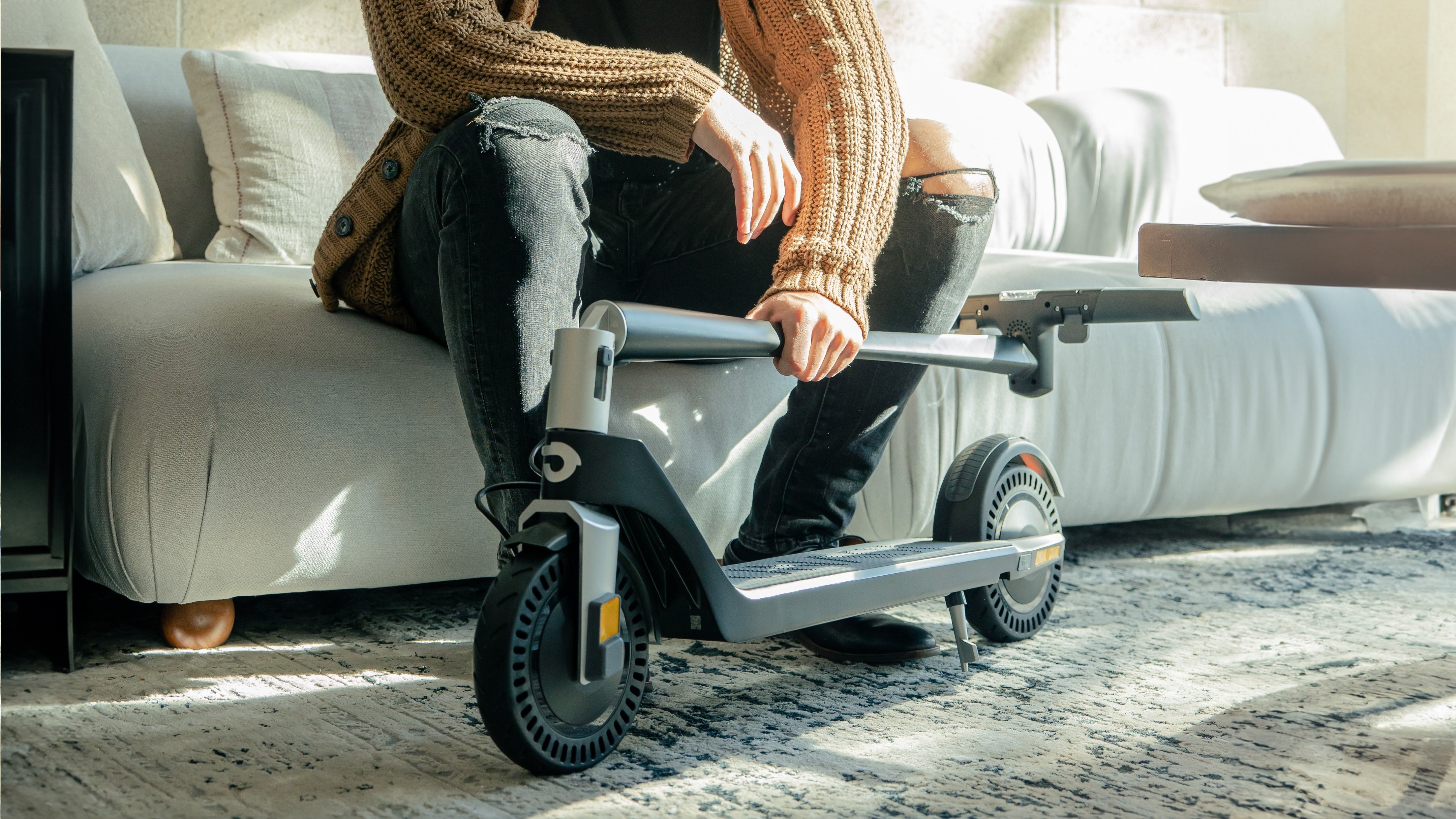Micromobility is here to stay, and it’s changing how we experience urban life for the better. With Unagi’s membership program, you can enjoy all the benefits of a top-tier electric scooter without the sky-high price of ownership or the inconvenience of ride-sharing.
Electric micro-mobility includes a diverse range of options such as electric bikes, electric scooters, electric skateboards, electric hoverboards, electric roller skates, and hybrid variations of these portable electric vehicles (PEVs). Choosing the ideal micro-mobility solution for you rests on several factors such as personal preference, commuting requirements, local regulations, pricing, skill level, safety considerations, and availability.
Each type of PEV boasts its own dedicated market with passionate enthusiasts, and today we'll delve into a comparison between electric scooters vs electric skateboards.
While both vehicles trace their origins back to manual versions, they have evolved into sophisticated electric-assisted modes of transportation, attracting diverse demographics and continually enhancing their efficiency.
This guide aims to assist potential buyers who may be uncertain about which option to choose, as well as those curious about the potential benefits of each. So, let's dive right in.
Understanding electric scooters

Electric scooters are personal electric vehicles designed for short-distance travel, encompassing various types tailored to different needs. To understand the distinctions among these types, it's essential to first examine the components that define their classifications.
Electric scooters are personal electric vehicles designed for short-distance travel, encompassing various types tailored to different needs. To understand the distinctions among these types, it's essential to first examine the components that define their classifications.
Key components of electric scooters
Motor(s)
They serve as the primary power source of an electric scooter and are typically housed within the wheels. They are responsible for converting electrical energy from the battery into mechanical energy, propelling the scooter forward. Some scooters, like the UNAGI Model One Voyager, feature dual motors to enhance power and performance, catering to experienced riders, those navigating challenging terrains, or individuals utilizing their scooters for purposes beyond casual commuting.
Battery

Typically enclosed within the deck or stem, the e-scooter battery stores and supplies electrical energy to the motor. Most modern scooters rely on lithium-ion batteries, although some models, such as those from Razor, may incorporate lead-acid battery packs. While each type has its advantages and drawbacks, their primary function remains to determine the scooter's range and runtime. Additionally, scooter batteries are rechargeable, with some models even featuring detachable units, allowing users to carry spares for extended use.
Typically enclosed within the deck or stem, the e-scooter battery stores and supplies electrical energy to the motor. Most modern scooters rely on lithium-ion batteries, although some models, such as those from Razor, may incorporate lead-acid battery packs. While each type has its advantages and drawbacks, their primary function remains to determine the scooter's range and runtime. Additionally, scooter batteries are rechargeable, with some models even featuring detachable units, allowing users to carry spares for extended use.
Braking mechanism
Electric scooters commonly employ four types of brakes: drum brakes, disc brakes, electronic brakes, and friction brakes. Manufacturers select the braking mechanism based on the scooter's power output, ensuring adequate stopping capabilities. For instance, models designed for children may utilize friction or stomp brakes, while high-performance scooters like the Kaabo Wolf King GTR often feature hydraulic disc brakes with robust stopping power. Some scooters incorporate regenerative braking, which not only aids in stopping but also recharges the battery, providing additional range.
Frame/Chassis
This serves as the backbone of the scooter, integrating all structural components while providing support for the rider. Typically, the chassis is crafted from lightweight materials like aluminum alloys, steel, or advanced materials like carbon fiber in premium models like Unagi, as these frames prioritize weight reduction, crucial for enhancing portability - especially for daily commuters.
Suspension
While considered an optional feature, suspension systems significantly enhance ride comfort, though it should be noted that they also add significant weight and cost to the scooter. These suspension systems absorb shocks and vibrations, smoothing out the ride and making it more enjoyable.
Wheels/Tires
Adult scooters typically feature two wheels that can either be solid rubber, air-filled pneumatic, or hybrid tires. In contrast, kids' scooters often come with three wheels - one at the front and two at the rear - for added stability. Tire choice significantly influences ride quality, with tread pattern playing a crucial role in determining suitability for on-road or off-road use.
Deck
This serves as the platform for the rider and is key in determining available riding positions. Riders with larger feet should pay attention to deck dimensions for optimal comfort. Grip is also essential for stability, with some decks featuring grip tape while others make use of textured rubber mats.
Accessories and Controls
They enhance the scooter's functionality and convenience and include levers for acceleration and braking, lights for visibility in low-light conditions, control buttons for intuitive operation, display screens for vital information like speed and battery level, fenders for splash protection, and rubber covers for improved grip on handles, among others.
Types of electric scooters
Having established a foundational understanding of electric scooters and their constituent parts, we now look at different scooter categories based on their different offerings.
Number of motors
This is the most common categorization and it distinguishes scooters by the number of motors they possess, which can be either single or dual. Dual-motor scooters have increased torque and acceleration compared to their single-motor counterparts.
Single-motor scooters typically excel in urban commuting or short-distance trips, while dual-motor variants are favored for off-road excursions or longer journeys requiring enhanced torque. The Unagi Model One Classic represents an affordable option in the dual-motor category, while the Segway GT1 stands out as a premium single-motor scooter.
Riding skill
Scooters are further classified based on the skill level necessary for their operation, catering to beginners, intermediate users, and experts. Starter scooters feature basic construction and lower power outputs, as exemplified by brands like GoTrax. Intermediate models offer increased power and speed, often introducing features such as suspension systems.
Expert-level scooters push boundaries with extreme speeds, advanced braking and suspension mechanisms, and meticulous design considerations like rake angles and stem stability, as demonstrated by high-performance models like the Dualtron X Limited, capable of reaching speeds up to 70 mph.
Purpose
This classification assesses the intended usage scenarios for scooters, spanning categories such as commuting, adventure, racing, casual riding, shared rides, and delivery services. There's often overlap with riding skill classifications, with commuting scooters typically appealing to beginners and intermediate riders, while adventure and racing scooters attract expert-level enthusiasts seeking high-performance capabilities.
Budget
Electric scooters are divided into various categories based on budget considerations, accommodating different financial capacities. These categories include budget or entry-level models, mid-tier options, and high-end or luxury variants.
Portability

Scooters are classified according to their portability features, encompassing foldable and non-foldable designs, as well as distinctions based on weight categories such as ultra-lightweight, lightweight, and heavy models. For instance, the Segway Air T15 weighs a mere 23.2 lbs, while the Dualtron X Limited tips the scales at a hefty 182.8 lbs.
The differentiation between portable and non-portable models also considers folded dimensions and their impact on transportation and storage convenience.
Riding style
Electric scooters offer flexibility in riding posture, accommodating both standing and seated positions to cater to individual preferences and comfort levels. Some scooters are purpose-built with integrated seats, such as the EMOVE Roadrunners, while others feature optional seat attachments like the Hiboy S2 Pro.
Terrain suitability
Scooters are categorized based on their suitability for different types of terrain, distinguishing between on-road, off-road, or hybrid versions capable of navigating urban streets and challenging trails alike.
Number of wheels
While adult scooters typically ride on two wheels, children's models may feature three wheels for enhanced stability and ease of use.
Why do people opt for electric scooters?
Let's explore the reasons driving the increasing popularity of these vehicles:
- They serve as ideal last-mile transportation solutions, bridging the gap between public transit stations and final destinations, thereby reducing reliance on cars and alleviating congestion in urban areas.
- Electric scooters are user-friendly, with a relatively simple learning curve that allows anyone to quickly master their operation.
- In terms of cost-effectiveness, electric scooters outshine gas-powered vehicles and rideshare services like taxis, offering savings both in initial purchase and maintenance expenses.
- Environmental consciousness is another compelling factor, as electric scooters present an eco-friendly mode of transportation with proven reductions in carbon emissions from manufacturing to their final trips.
- Legally authorized for use in many regions, electric scooters can be ridden on bike lanes without fear of violating local regulations, although it's essential to familiarize oneself with pertinent laws surrounding e-scooter use.
- Foldable and portable scooter options offer added convenience, enabling users to transport them effortlessly and store them without taking up significant space.
- Beyond practicality, electric scooters offer a fun mode of transportation. They facilitate faster travel compared to walking and offer an alternative to crowded and stuffy public transit systems, enhancing the overall journey experience.
Understanding electric skateboards

At first glance, electric skateboards may seem identical to their traditional counterparts. However, these e-skates, or esk8s, as they're popularly known, distinguish themselves by utilizing electric power for propulsion through integrated motors and batteries. Electric skateboards come in various forms, each tailored to specific preferences and riding styles.
Types of electric skateboards
Longboards
Longboards, as their name suggests, feature elongated and wider decks, typically spanning 36 to 42 inches in length. They are the most common type of electric skateboard and are often recommended for beginners due to their spacious platforms, which facilitate comfortable steering.
Longboards are also outfitted with larger and softer wheels, which, paired with the big deck, make for a more stable ride. They are preferred for cruising thanks to their ease of riding, their ability to withstand mildly challenging terrain, and their typically higher range potential. Moreover, longboards feature higher weight capacities, further enhancing their appeal.
Shortboards
Shortboards, aptly named for their relatively compact deck size compared to traditional skateboards and longboards, typically measure between 30 and 36 inches in length. And while electric skateboarding isn't typically associated with performing stunts, shortboards offer a semblance of maneuverability, agility, and control comparable to traditional skateboards.
Geared towards more experienced riders, shortboards offer increased power and speed, making them suitable for racing or freestyle riding. However, thanks to the smaller wheels, shortboards have less stability at high speeds and on uneven terrain, making them less advisable for beginners. Nonetheless, their compact dimensions render them more portable, facilitating easier transportation over distances, and they often come at a more affordable price point.
Off-road skateboards
Also known as all-terrain (AT) skateboards or colloquially dubbed the "monster trucks" of skateboards, off-road skateboards distinguish themselves by their larger size and weight. These boards feature oversized rubber tires, sometimes reaching up to 10 inches in diameter, and equipped with deep treads for enhanced traction. Additionally, they have wider trucks, powerful dual motors, sophisticated electronic speed controllers (ESCs), and large batteries. These robust components are specifically engineered to tackle challenging terrain such as grass, gravel, sand, mud, and hills.
Some manufacturers even integrate suspension systems, exemplified by models like the Propel Endeavor2 Pro, and incorporate features like tire mudguards to optimize performance. In contrast to other types of e-skateboards crafted from plastic or wood, off-road skateboards often utilize more durable materials like bamboo and carbon fiber, striking a balance between stiffness and flexibility tailored to their intended riding style.
However, while excelling in off-road environments, these boards are less suitable for paved surfaces and are less convenient for portability.
Electric penny boards
Originating from Australia, electric penny boards cater primarily to beginners with their simplistic design. Typically featuring a plastic deck and small wheels, penny boards are compact and lightweight, making them effortless to carry when not in use. Moreover, they serve as an affordable entry point for individuals seeking to explore the world of electric skateboarding without committing to more advanced models.
Features and components of electric skateboards
The typical electric skateboard features a deck, battery, motor, wheels, truck, ESC, and a remote control.
Let's examine the roles each of these features plays in the operation of electric skateboards:
Motor
The e-skate motor serves as the primary source of power to propel the rider forward and can vary in size and power output depending on the specific model. Electric skateboards commonly employ three distinct driving methods:
Hub motor drive
Integrated within the wheel of the skateboard, and wheel hub motors are commonly enclosed in a polyurethane or rubber sleeve. This motor configuration offers a streamlined appearance and contributes to a quieter and more efficient riding experience. Another advantage is that these encased motors offer enhanced protection against damage from external elements. That said, hub motors typically provide less torque, resulting in moderate acceleration. In addition, replacement costs can be high in the event of motor damage, and the design limits the variety of wheels that can be installed on the e-skateboard.
Direct-drive motor
Positioned between the truck and wheels, direct-drive motors connect directly to the wheel. The direct connection enables freerolling, allowing electric skateboards to function as a normal kick skateboard even when the battery is depleted. In addition, direct-drive motors offer quiet operation and accommodate a wider range of wheel options compared to hub motor drives. However, the exposed nature of the rotor makes it vulnerable to damage from external elements and scraping when riding over uneven terrain.
Belt drive
Considered the most common motor configuration on electric skateboards, belt-drive systems have been widely used for a long period and are renowned for their efficiency. Operating similarly to pulley mechanisms, belt-drive motors are positioned near the driving wheel and connected via a belt mechanism. While this setup entails more moving parts and the potential for breakage, it offers numerous advantages, such as increased torque, power, and responsiveness. Belt-drive motors also excel in negotiating challenging terrain and are easier to maintain. Accordingly, electric skateboards designed for all-terrain usage typically feature this motor configuration.
Deck
Typically constructed from a variety of materials such as wood, plastic, carbon fiber, or composite materials, the deck of an electric skateboard is expertly designed to offer stability and support. The selection of materials, design intricacies, and construction methodologies significantly impact the following electric skateboard specifications:

Typically constructed from a variety of materials such as wood, plastic, carbon fiber, or composite materials, the deck of an electric skateboard is expertly designed to offer stability and support. The selection of materials, design intricacies, and construction methodologies significantly impact the following electric skateboard specifications:
Stability
The stability of the electric skateboard is closely linked to the dimensions of the deck, particularly its length and wheelbase. Longer decks and extended wheelbases typically translate to heightened stability, especially when navigating uneven terrain or cruising at higher speeds.
Support
The deck is the primary platform for the rider's feet, providing essential support. The surface texture and contouring of the deck surface further enhance grip and foot placement, leading to increased stability and control for the rider.
Customization

Electric skateboard enthusiasts frequently customize their decks to suit their unique riding preferences and aesthetics. This may entail selecting decks with unique shapes, concave profiles, or eye-catching graphics, thereby enabling riders to personalize their riding experience and showcase their individuality.
Battery and Charging Time
Electric skateboards commonly utilize either lithium-ion batteries or lead-acid batteries. Lithium-ion batteries are favored for their lighter weight, higher energy density, and longer lifespan. Riders should carefully consider the range of the skateboard to determine the appropriate battery capacity that best suits their needs. Also, look out for a shorter charging time as it allows for more frequent and uninterrupted riding experiences.
The weight and size of the battery also play a major role. Heavier batteries can significantly impact the maneuverability and portability of the electric skateboard, making it more challenging to navigate and transport. Thus, it is essential to strike a balance between battery weight and range to optimize the riding experience. It is also worth noting that larger-capacity batteries typically cost more due to their enhanced performance and extended range capabilities.
Wheels
When selecting wheels for an electric skateboard, riders should consider various factors, such as size, firmness, durability, and performance characteristics.
Wheel size and firmness
The size and firmness of the wheels directly influence the skateboard's performance on different surfaces. Larger wheels tend to provide a smoother ride and better stability, especially when traversing uneven terrain. Firmer wheels offer increased speed and durability, making them suitable for cruising or commuting purposes.
Wheel material
E-skate wheels are typically made from polyurethane, rubber, or specialized compounds designed for specific applications. Polyurethane wheels are renowned for their durability and are ideal for everyday commuting or cruising, as they can withstand the sustained impact of rough surfaces.
Rubber tires, on the other hand, offer a smoother and quieter ride due to their softer and more flexible composition. They also provide superior traction on slippery surfaces but may wear out faster over time.
Trucks
This is the pivotal connection between the wheels and the deck. Trucks play a crucial role in determining the maneuverability and stability of the electric skateboard. Similar to those found on traditional skateboards, trucks are responsible for facilitating turns and absorbing shocks during rides. Factors to consider when evaluating trucks include their width, height, and materials used in construction.
Electronic Speed Controller (ESC)
The Electronic Speed Controller (ESC) is a vital component of an electric skateboard, responsible for regulating the speed and acceleration of the board. It's the intermediary between the user and the motor that receives signals from a handheld remote control and adjusts the power output to the motor accordingly. Some ESCs, such as Variable ESCs (VESCs), incorporate advanced functionalities beyond basic speed regulation such as motor and battery protection mechanisms to prevent overheating or overloading, as well as regenerative braking systems.
Remote control
The handheld remote control allows the rider to adjust speed settings, initiate braking maneuvers, and monitor key performance metrics such as battery level and speed. It typically communicates with the ESC via wireless technologies such as Bluetooth or radio frequency (RF).
Why choose electric skateboards for transportation?
There are numerous reasons why individuals opt for electric skateboards as a mode of transportation, including:
- Their compact size and lightweight design make electric skateboards easy to carry around and store, offering convenience for commuters and travelers.
- Electric skateboards provide an eco-friendly mode of travel, emitting zero emissions and reducing reliance on fossil fuels.
- Electric skateboards offer an exhilarating riding experience, appealing to enthusiasts and adrenaline seekers alike.
- Many riders use electric skateboards for recreational cruising and exploring urban environments, adding enjoyment to their daily routines.
- With a wide variety of models and configurations available, riders can find electric skateboards that entirely suit their riding preferences and needs. They are also available at various price points, with entry-level models costing as low as $200.
Comparison between electric scooters and electric skateboards
Speed and acceleration
Electric scooters generally allow for higher speeds and faster acceleration compared to electric skateboards. Most electric skateboards have speed limits capped at around 40 mph. The OMW Calvary and the Acedeck Nyx Z1 are some of the fastest e-skate models, with claimed top speeds of 37 mph.
On the other hand, custom scooters like the Rion RE90 can reach claimed top speeds of 100 mph with production scooters like the Kaabo Wolf King GTR achieving tested speeds of 65.8 mph. This speed advantage is largely attributed to the larger-capacity motors found in scooters, which also provide greater torque for quicker acceleration and improved hill-climbing capabilities.
Range
In terms of range, electric scooters typically go for longer distances on a single charge due to their ability to accommodate larger batteries. However, advancements in electric skateboard technology, such as the Propel Endeavor2 Pro with an 1110 Wh battery claiming a range of 44 miles have pushed the boundaries of what is achievable with e-skates. Alternatively, a scooter like the Dualtron X Limited has a massive 5040 Wh battery with a claimed range of 100 miles, showing the extreme disparity in range capabilities.
Terrain versatility

Electric scooters are often considered more versatile in handling various surfaces and terrains. Their larger wheels provide better stability and traction, while features like suspension systems absorb shocks and vibrations, and handlebars offer superior navigation control compared to the foot steering of electric skateboards. Nonetheless, electric skateboards have made significant strides in off-road adaptations, and for regular cruising, they can rival the performance of many electric scooters.
Electric scooters are often considered more versatile in handling various surfaces and terrains. Their larger wheels provide better stability and traction, while features like suspension systems absorb shocks and vibrations, and handlebars offer superior navigation control compared to the foot steering of electric skateboards. Nonetheless, electric skateboards have made significant strides in off-road adaptations, and for regular cruising, they can rival the performance of many electric scooters.
Safety features
Electric skateboards are gradually incorporating more safety features, although they are limited by weight restrictions and physical capacity for gadget installation. Some skateboards feature built-in safety mechanisms such as dead switches to prevent accidental acceleration, Variable ESCs (VESCs) with motor and battery protection, and weight sensors for speed regulation. In contrast, electric scooters offer a wider array of safety features including high-mounted headlights, horn/bell systems, anti-theft alarms, traction control, GPS tracking systems, and anti-lock braking systems (ABS), placing them ahead in terms of safety technology.
Cost comparison
With a wide variety of models available, there is an electric scooter and electric skateboard available for various budgets. The best budget electric scooters and top affordable electric skateboards have a base price of around $400. While cheaper options can be found for as low as $250-$300, many of these compromise on quality, safety, performance, ride comfort, and durability.
However, outside of budget-level offerings, there are more price categories for e-scooters than e-skates. For perspective, the Acedeck Nyx Z1, one of the most expensive electric skateboards, costs $2699, whereas the Dualtron X Limited, one of the most expensive production scooters, is priced at $6995.
In terms of maintenance, electric scooters may incur higher costs due to their larger number of moving parts compared to electric skateboards.
Portability and storage
Electric skateboards are generally more compact and offer better portability compared to electric scooters. With weights typically ranging from 15-28 lbs, electric skateboards are lightweight and easy to carry when not in use. They can also be conveniently stored in compact spaces such as closets or under desks. Conversely, there are ultraportable scooters available for those prioritizing convenience in carrying and storage, such as the Unagi Model One Classic scooter weighing in at just 28.5 lbs. At the same time, higher-performance scooters often sacrifice portability, with many performance models weighing over 100 lbs.
Suitability for different users

Electric scooters are generally more user-friendly, especially for novice riders, compared to electric skateboards. They have become more mainstream and are considered suitable for riders of all ages and skill levels, making them a versatile option for families.
Electric scooters are generally more user-friendly, especially for novice riders, compared to electric skateboards. They have become more mainstream and are considered suitable for riders of all ages and skill levels, making them a versatile option for families.
On the other hand, skateboarding requires a certain level of skill and balance, making electric skateboards more niche in appeal. However, learning to ride an electric skateboard is relatively straightforward, and it is accessible to individuals of any demographic–it may be less common to see older individuals cruising on electric skateboards, but it is certainly feasible.
Ultimately, the suitability of each vehicle depends on the preferences and needs of the individual rider.
Comfort and ergonomics
Electric scooters generally provide a more comfortable riding experience due to their ergonomic designs. They typically feature wider decks, handlebars for steering and stability, larger wheels, optional suspension systems, and in some cases, seat options. The riding position on electric scooters is also more relaxed compared to electric skateboards, with adjustable handlebars available to accommodate riders of different heights. While ride comfort may not be a significant factor for occasional short commutes, it becomes essential for longer or more frequent rides, making electric scooters the preferred choice.
Learning curve
In terms of ease of learning, electric scooters are generally easier to master compared to electric skateboards. They offer intuitive controls and a more stable riding platform, making them accessible to riders of all skill levels. On the other hand, while mastering riding an electric skateboard is not overly difficult, it does require a higher skill level to achieve balance and coordination, particularly when navigating turns and hills. However, with determination and practice, riders can become proficient on electric skateboards as quickly as they would on electric scooters.
Customization options
Both electric scooters and electric skateboards offer a variety of customization options and aftermarket accessories to enhance the riding experience. Electric scooters typically offer more opportunities for customization due to their design, including options for modifying handlebars, decks, lights, suspension systems, and more. In contrast, customization options for electric skateboards are often limited to deck designs, grip tape, trucks, and wheels.
Legal considerations
The legal landscape for both electric scooters and electric skateboards varies depending on the region and understanding the regulations governing these devices in your area is essential. This includes familiarity with scooter regulations and electric skateboard laws, such as the legality of riding these devices, any riding restrictions in place (such as where they can be ridden and speed limits), age requirements, and laws concerning safety gear.
Energy efficiency
Both electric scooters and electric skateboards offer eco-friendly transportation options that contribute to reducing carbon emissions when compared to traditional gasoline-powered vehicles. However, electric scooters typically boast more efficient motor configurations and larger batteries, making them a more practical choice for daily commuting and reducing energy consumption.
Conclusion
Electric scooters and electric skateboards are poised to shape the future of urban mobility, offering sustainable, efficient, and enjoyable alternatives to traditional transportation methods. However, the comparison between the two PEVs reveals a complex landscape of options catering to diverse preferences, needs, and lifestyles.
While electric scooters excel in comfort, ease of use, and versatility for various age groups and skill levels, electric skateboards offer unique advantages in portability, customization options, and a thrilling riding experience.
Ultimately, deciding between an electric scooter and an electric skateboard boils down to personal priorities, whether that's comfort, performance, or portability. A clear understanding of their key differences, alongside considerations like cost, maintenance, legal implications, and energy efficiency, enables riders to make well-informed choices that best suit their lifestyle and preferences.
Try out the Unagi All-Access Scooter Subscription today, and rent yourself a brand new Unagi from as little as $39/month.

Stay current with the latest U.S. electric scooter laws in our 2025 guide. Updated annually since our first comprehensive guide, ensuring you have the most recent state and city regulations to ride responsibly”

The Slack Core 920R is currently the fastest electric scooter in 2025 that you can purchase without the need for pre-order.

Our selection of the best electric scooters 2025 spans the fastest e-scooters to the most portable ones, the ones designed for city riding and off-road, the best scooters for rain, budget electric scooters for students, and more powerful ones for skilled riders.

The Unagi Voyager is the best lightweight electric scooter for adults and teenagers. It is the ultraportable sequel to its predecessor, the Unagi Model One Classic.

If you're wondering whether an electric scooter with a seat is right for you, this is a detailed article that would suit your need.

Understand which personal electric vehicle is best, the choice between an electric bike or electric scooter might already be made for you by some critical factors, including portability and storage capacity.

In the U.S., most states don't require a license. For those that do, they usually just ask for a regular driver's license or a learner's permit.

Yes, you can bring an electric scooter on a plane, but it needs to have a lithium battery smaller than 100 watt-hours, which most don't.

Manufacturers advise against riding electric scooters in the rain. The main reasons are: water can fry the electronics, make the ride dangerous, and void your warranty.

The basis and the premise of my work is that we either operate out of love or we operate out of fear...Time is currency. The coolest thing about the scooters is that it's really quick, and it goes uphill. From there, traveling more efficiently and having a good time doing it--I think that's the most important thing.

Cynthia Leu has a full plate. A tech worker by day, Cynthia spends her off time balancing the parallel lives of a powerlifter, entrepreneur, mental health advocate, and more. Riding Unagi helps this USMC veteran cut down on everyday…

https://www.youtube.com/watch?v=7m2hVBE62LY Rasheed Muhammad is sick of Los Angeles traffic. In order to preserve his sanity, Rasheed has traded his everyday driving habit for the portable and beautiful Unagi Model One. It’s an essential accessory for navigating LA streets -- and…

Rich Lee, Co-Founder of San Francisco’s SPRO Coffee Lab, wants to share his love for coffee with the world. He depends on riding Unagi to avoid the hassle of navigating the parking crunch in the booming Mission Bay neighborhood.…












